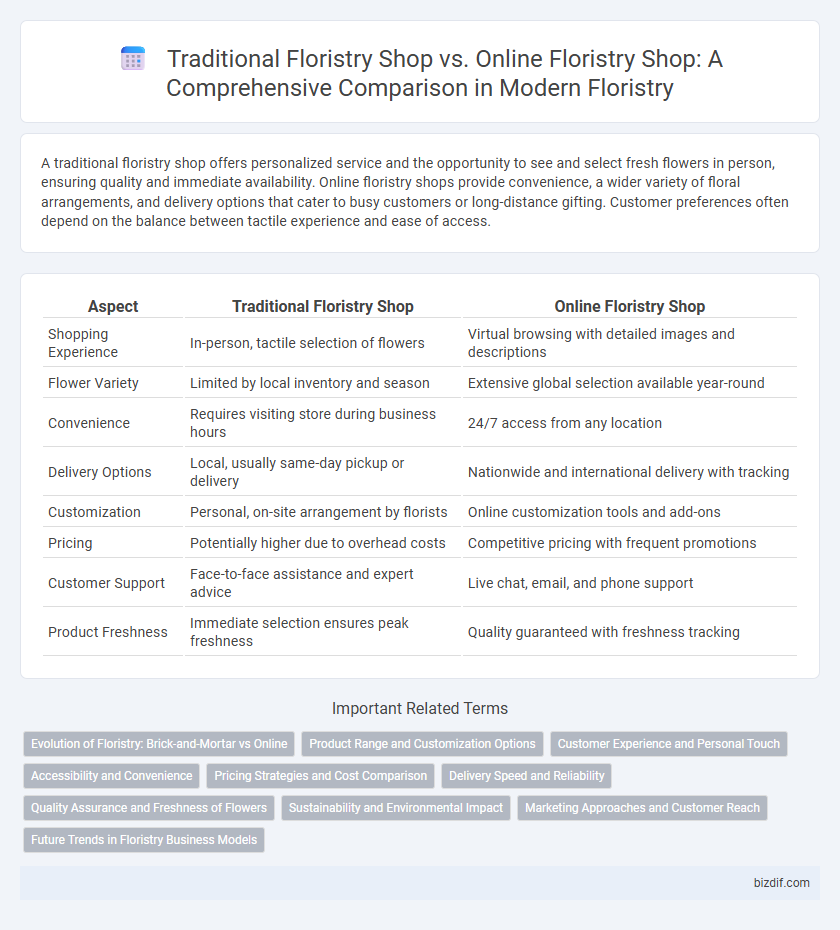A traditional floristry shop offers personalized service and the opportunity to see and select fresh flowers in person, ensuring quality and immediate availability. Online floristry shops provide convenience, a wider variety of floral arrangements, and delivery options that cater to busy customers or long-distance gifting. Customer preferences often depend on the balance between tactile experience and ease of access.
Table of Comparison
| Aspect | Traditional Floristry Shop | Online Floristry Shop |
|---|---|---|
| Shopping Experience | In-person, tactile selection of flowers | Virtual browsing with detailed images and descriptions |
| Flower Variety | Limited by local inventory and season | Extensive global selection available year-round |
| Convenience | Requires visiting store during business hours | 24/7 access from any location |
| Delivery Options | Local, usually same-day pickup or delivery | Nationwide and international delivery with tracking |
| Customization | Personal, on-site arrangement by florists | Online customization tools and add-ons |
| Pricing | Potentially higher due to overhead costs | Competitive pricing with frequent promotions |
| Customer Support | Face-to-face assistance and expert advice | Live chat, email, and phone support |
| Product Freshness | Immediate selection ensures peak freshness | Quality guaranteed with freshness tracking |
Evolution of Floristry: Brick-and-Mortar vs Online
Traditional floristry shops offer tactile experiences with personalized consultations and immediate product availability, preserving artisanal techniques passed down through generations. Online floristry shops leverage digital platforms, broadening access to diverse floral designs, real-time inventory updates, and convenient delivery options. The evolution from brick-and-mortar to online floristry reflects a shift driven by technology, consumer behavior, and supply chain innovations.
Product Range and Customization Options
Traditional floristry shops offer a curated selection of fresh, locally sourced flowers with personalized in-store customization, allowing customers to see and feel product quality before purchase. Online floristry shops provide a broader product range, including exotic and seasonal varieties unavailable locally, with advanced customization tools enabling detailed design preferences and delivery scheduling. Both formats cater to diverse customer needs, but online platforms excel in variety and convenience while traditional shops emphasize tactile experience and immediate consultation.
Customer Experience and Personal Touch
Traditional floristry shops offer customers the tactile experience of selecting fresh flowers in person, allowing for immediate customization and face-to-face consultation that enhances personal connection and trust. Online floristry shops provide convenience and a wider variety of floral arrangements, with detailed photos and customer reviews that simplify decision-making but may lack the intimate, hands-on interaction of physical stores. While in-store visits foster emotional engagement through sensory input and expert guidance, online platforms optimize accessibility and speed, catering to varied customer preferences.
Accessibility and Convenience
Traditional floristry shops offer personalized, face-to-face service with immediate product inspection, but they are limited by store hours and geographic location. Online floristry shops provide 24/7 accessibility from any location, allowing customers to browse extensive floral selections and schedule deliveries effortlessly. The convenience of online ordering and home delivery often surpasses the tactile experience of in-store shopping, especially for busy or remote customers.
Pricing Strategies and Cost Comparison
Traditional floristry shops often have higher overhead costs such as rent, utilities, and in-store staff, leading to premium pricing on floral arrangements. Online floristry shops benefit from streamlined operations and reduced physical expenses, enabling more competitive pricing and frequent promotional offers. Customers seeking cost-effective options typically find better value in online floristry due to bulk purchasing and lower operational costs passed on as savings.
Delivery Speed and Reliability
Traditional floristry shops often provide same-day, personalized delivery services with a strong emphasis on quality and freshness, enhancing reliability through direct handling of flowers. Online floristry shops leverage advanced logistics and extensive delivery networks to offer rapid shipping options, including next-day and even express delivery across wider geographic areas. While traditional shops excel in bespoke arrangements with guaranteed freshness, online platforms prioritize speed and convenience, backed by tracking systems that improve delivery reliability.
Quality Assurance and Freshness of Flowers
Traditional floristry shops ensure quality assurance and freshness through direct handling and daily local flower deliveries, allowing florists to select and maintain blooms in optimal condition. Online floristry shops rely on advanced cold chain logistics and rapid delivery systems to preserve freshness while offering a broader selection of exotic flowers. Both models prioritize careful packaging and quality control protocols to guarantee vibrant, long-lasting floral arrangements upon arrival.
Sustainability and Environmental Impact
Traditional floristry shops often source locally grown flowers, reducing carbon emissions associated with long-distance transportation and supporting sustainable farming practices. Online floristry shops can leverage centralized distribution centers to optimize delivery routes, potentially lowering their overall environmental footprint despite longer shipping distances. Both models face challenges in waste management, with traditional shops needing efficient floral waste disposal and online shops focusing on eco-friendly packaging solutions.
Marketing Approaches and Customer Reach
Traditional floristry shops rely on local marketing strategies such as community events, in-store promotions, and word-of-mouth to attract nearby customers, leveraging personal relationships and immediate product availability. Online floristry shops utilize digital marketing tactics including search engine optimization (SEO), social media advertising, and email campaigns to reach a broader, global audience and provide convenience through home delivery. The integration of customer data analytics in online platforms enhances targeted marketing, driving personalized offers and customer retention far beyond the geographical limitations faced by traditional stores.
Future Trends in Floristry Business Models
Traditional floristry shops emphasize personalized, tactile experiences and local flower sourcing, maintaining strong community ties prevalent in their business model. Online floristry shops leverage digital platforms, AI-driven customer preferences, and same-day delivery innovations to capture a broader market and offer convenience. Future trends indicate a hybrid model integrating augmented reality for virtual bouquet previews and sustainable, eco-friendly supply chains, enhancing customer engagement and environmental responsibility.
Traditional floristry shop vs online floristry shop Infographic

 bizdif.com
bizdif.com